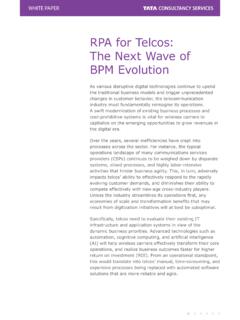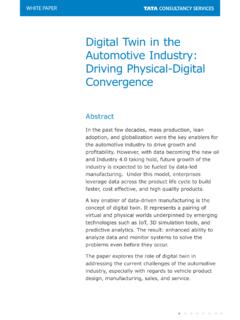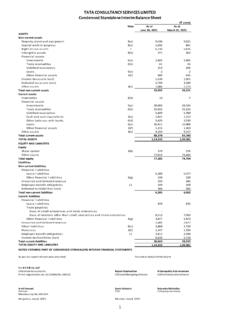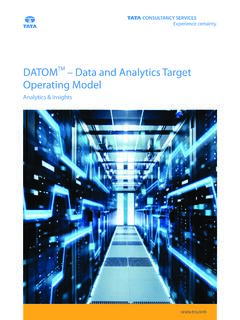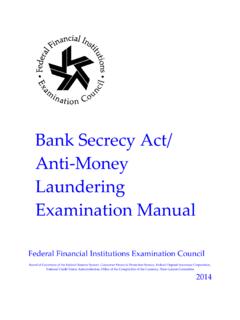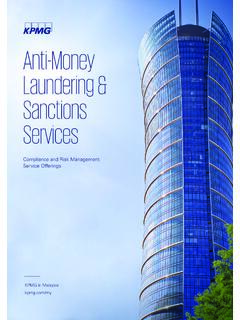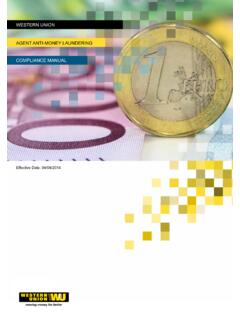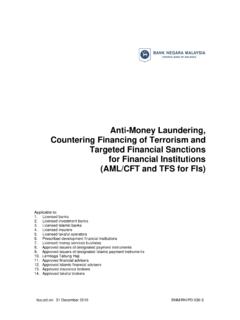Transcription of Anti-Money Laundering: Challenges and Trends
1 WHITE PAPERAnti- money laundering : Challenges and TrendsAbstractThe inadvertent use of the banking system for money laundering activities is a key challenge facing the financial services industry. In response, regulatory authorities have introduced Anti-Money laundering (AML) regulations to detect and prevent such activities. Complying with these regulations requires banks and financial institutions to implement an effective compliance system, along with appropriate tools and systems. This, in turn, requires companies to build an effective business case for the right compliance system equipped with requisite capabilities and latest technology paper discusses the Challenges before banks and financial institutions, prevailing industry Trends , and how emerging technologies can be used to monitor transactions to identify suspicious activities.
2 Some Challenges that Exist TodayBanks and financial institutions are facing some serious AML compliance Challenges that can be typically attributed to faulty mitigation approaches. Firms that fail to prevent laundering tend to pay a heavy price in the form of declining revenues, customer dissatisfaction, huge penalties, loss of reputation, and fall in stock prices. To comply with AML regulations, banks around the world use various technology-based products and solutions. The Financial Action Task Force (FATF), an inter-governmental body with 37 members the world over, has framed a set of regulations that is recognized as an international framework of AML standards.
3 These AML regulations help detect, report, and prevent suspicious activities at financial face several Challenges in managing risks involved in assessing the current AML status and identifying vulnerabilities. Disparate transactions and increasing complexities of fraud and cybercrimes compound the situation. To address these Challenges , banks need to ensure data protection, detect fraud in time, and prioritize compliance with the FATF are the other Challenges banks face: Increased governance: Banks and financial institutions can find it difficult to manage cross-border and multi-jurisdictional AML-compliance requirements and ever-growing customer due diligence requirements.
4 Identifying beneficial ownership and initiating remedial measures to address AML gaps uncovered by regulatory reviews also come with their own set of of skilled personnel: Getting skilled resources with in-depth knowledge of AML can be a challenge. Other issues include high on-boarding timelines and costs, and attrition. Organizations also need to invest considerable time and effort in keeping personnel abreast with changing regulatory requirements. WHITE PAPERC omplicated processes and technology: AML compliance requires banks to put in place a multiplicity of processes and technology solutions that will consolidate KYC data and systems in a single repository.
5 They also need to create infrastructure for cross-channel detection of suspicious activities, improve data quality, and standardize data to enable centralized analysis of fraud and financial crimes. The risk level assigned during on-boarding varies according to the transactions undertaken by the customer. This means that banks have to assess the risks dynamically for each customer, and change risk levels accordingly, to prevent false positives. This necessitates continual transaction monitoring for each customer, which is a mammoth Trends in the AML SpaceA new paradigm is emerging wherein principle-based AML systems grounded in scientific disciplines are replacing inflexible rules-based solutions.
6 Some emerging Trends in AML compliance are:Focus on digital payment-related issues: Regulatory focus is currently centered on containing money - laundering risks associated with new payment methods like mobile wallets, e-payments, and e- money issuers. In addition, top priority is being accorded to combating cybercrime and curbing potential money - laundering risks associated with virtual of third-party utilities: Third-party services such as the shared services utility model for KYC compliance, managed services for transaction monitoring, and browser-based delivery of commercial watch lists are being leveraged by several banks. Financial institutions are using the expertise of third-party providers for KYC verification and due diligence, and to spot new AML risks and violation of enterprise-level approaches: Enterprise-wide case management for an overall view of risks at the enterprise level, and effective centralized control is becoming the norm.
7 Banks are also implementing AML or fraud platform convergence capable of detecting both WHITE PAPER fraud and money - laundering activities to derive operational synergies. Risk-based approaches are replacing traditional rule-based approaches. Adoption of analytics: Banks are adopting analytics for their AML initiatives. Some areas where analytics can be used successfully include: Fraud detection: Advanced filtering technologies and analytics for real-time fraud detection and generation of alerts based on changes in behavior patterns are gaining ground. Banks are also using high-tech linkage analysis (network visualization) to detect suspicious activities and track money trails.
8 They are using cross-channel detection support to get an integrated view of suspicious activities across all payment types and anti -stripping technology to detect masking or manipulation of wire transfer data. Screening: Banks are tapping social media as an additional source of information to validate customer identity, identify politically exposed persons (PEP), and obtain default information for account reviews of a customer. Banks are leveraging social media analytics to support their enhanced due diligence (EDD) process, which includes negative media screening efforts for discovery of litigations, adverse orders, and other potential risks.
9 Banks are also using software for sanctions screening, which results in benefits such as reduced timelines for enhanced due diligence; faster and informed decision making; quicker identification of key risks associated with companies, management teams, and other affiliates; and faster processing of transactions and monitoring of alerts. Detection of rogue activities: Banks are using analytics to detect anomalies and identify patterns indicative of laundering , and detect and prevent suspicious activities in real time. High speed streaming and computing to handle transaction data in all formats, parallel processing of transaction data and data from other channels, and high-speed alert generation and processing are other Trends that are catching up.
10 WHITE PAPER Linkage detection: Banks and financial institutions are using analytics to detect entity-level linkages, and study the behavior of different linked accounts colluding for a laundering activity. Some of the linkages that can be tracked include: Linked customer: To identify IDs owned by the same customer across lines of business. Linked accounts: To track customers having multiple accounts under different names. Linked transactions: To track transactions linked to a closed group of entities and performed with a clear intention of routing money to destination accounts Linked access: To track transactions happening through common cyber infrastructure.

